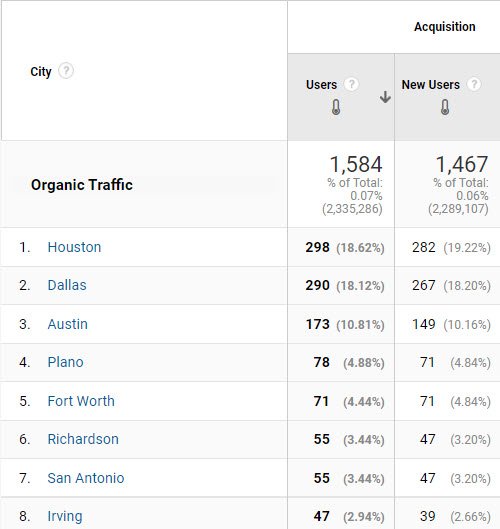Guided by the compass of the local search microcosm and armed with the blade of user intent, we can now bravely delve into the cave of local keyword data. This is part three of my series on Local SEO, and today we’re really doing it! We’re grabbing a trusty spreadsheet and compiling the phrases to optimize, track, and rank in a local market.
There are four types of data to consider when completing local keyword research:
- Search Console and Local Analytics Traffic
- Population, Dialect
- Keyword Planner
- Other Tools (Ahrefs, Semrush, etc.)
We’ll gather data for an HVAC company in Texas, considering how each type of information fits into the local search microcosm and how it contributes to an overall strategy.
Search Console and Google Analytics
Data from Google should never be ignored. Google Analytics and Search Console are immediate assets for better understanding how users find a website on search engines.
Because Google Analytics is transitioning from an old platform (Google Analytics 3) to an updated version (Google Analytics 4), I’ll provide information about accessing location data on both versions.
Google Analytics 3
Google Analytics 3 includes information about user locations under Audience>Geo>Location. Be sure to filter the segment to “Organic” and set the date range to anywhere from the last 3-6 months. At this point, you’re gathering the data to get a sense of what’s successful, so a quick check is all that’s needed.
Generally, Google Analytics data reports on the larger community, lumping the smaller suburbs together.
Google Analytics 4
Google Analytics 4 (GA4) uses a different data gathering method than Google Analytics 3, so the numbers will be slightly different between platforms.
GA4 location data is accessible under Demographics>Demographic Details. Then, you need to configure the data by clicking “Add Comparison” to insert two Conditions:
First, filter to Organic traffic by selecting “User Medium” and “organic” for the Dimension value.
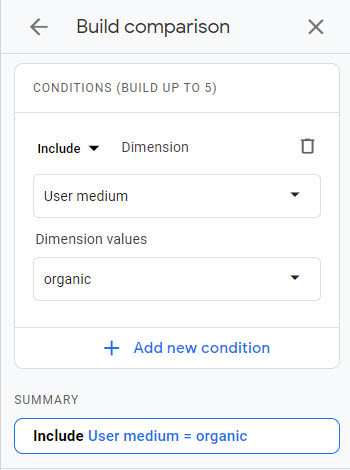
Then, click “Add new condition,” and for this example, select “Texas” for the region.
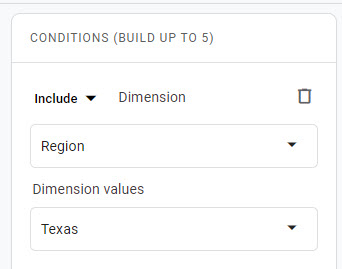
Finally, select “City” from the dropdown on the dashboard (it defaults to “Country”) to view the locations in the defined region. Now, we can filter traffic to the organic user medium in GA4 and see how many users are visiting from a specific region.
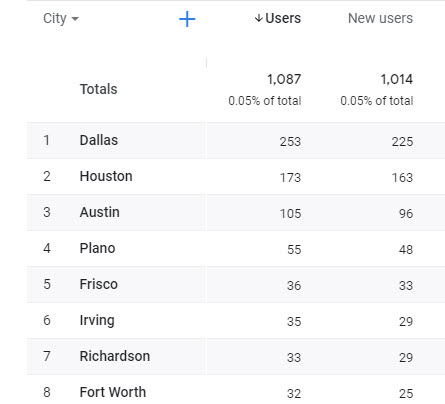
From this data, we can see that the Houston and Dallas communities deliver the most traffic to our site, which makes sense. They have high population density, therefore more people to drive numbers and engage with the site as a whole. But are national rankings driving this traffic or local queries?
If you have local landing pages, you can also use Google Analytics to understand which of these pages are receiving the most traffic. Local pages are a more specific metric than general location data because it’s unlikely for a local landing page to garner national rankings. To learn more about why people visit from these cities, we can dive into Search Console’s query data.
Search Console Keyword Data
Search Console provides performance data under “Search Results” about the average position, impressions, and clicks for a keyword.
Two factors should be considered when reviewing local query data in Search Console:
- Keyword Type
- Location
Sorting by keyword type helps us transform raw lists of data:
- Ac repair mckinney
- Mckinney air conditioning
- Furnace frisco
- Plano hvac repair
- Austin heating and cooling services
- Garland ac repair
- Heating Arlington
- Emergency boiler repair Richardson
Using specific formulas in Google sheets, we can organize the data into frequency and traffic for each keyword:
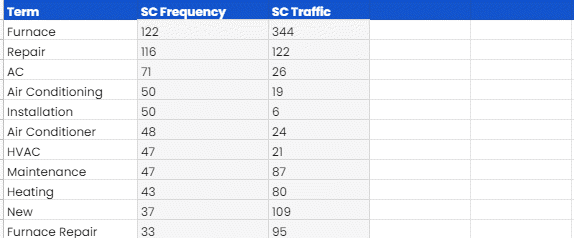
The “SC Frequency” column tells me how many times the phrase repeats on my master list. So, phrases containing “furnace” repeated 122 times across all locations. If variants of a phrase like “furnace” appear more often, theoretically, this should mean the site has been locally recognized for “furnace.” Frequency data adds context around which terms are delivering high volumes of traffic—the website generally performs better for “furnace” terms than for “air conditioner” terms.
Once keyword groups are prioritized, we can then use the same formulas to group Search Console query data by location, sorting it into geographic “buckets” where the website is ranked. This time, we’ll look at the total number of clicks that location received in the last 3-6 months, as well as the average position.
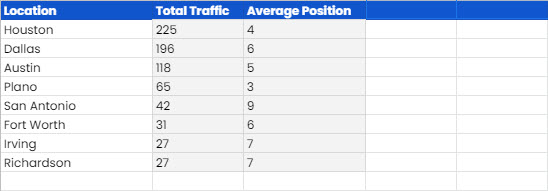
Search Console location data is useful because it considers engagement directly from user queries rather than general location. Unlike Google Analytics, it doesn’t just tell you how many people visited from the Dallas area; it includes any user who actively typed “Dallas.” When we put this data together, we start to get a clear picture of how and where users are finding the site.
In this example, traffic is spread relatively evenly across three populous cities in Texas (Austin, Houston, Dallas). It’s not surprising that places with more people also bring more people to the website. But if the client says Dallas is their top priority, and it’s almost at parity with the other locations, then I know the current keyword strategy isn’t working. A keyword strategy is driven by what’s working and what needs help—the selected keywords should consider both of these factors.
By setting data-based expectations, the keyword research starts from a place of context in the local search microcosm. With Google’s data, we understand how the specific website functions in the specific context of the local market, rather than trying to guess with generic volume data.
Population, Dialect
Population data is important to an organization’s overall location targeting strategy. As an important part of the local search microcosm (it’s the “location” part of this framework), the website’s location strategy aligns user behavior with marketing priorities.
For example, a Texas HVAC company might share these target locations as a high priority for rankings:
- Dallas, population 1,331,000
- Houston, population 2,310,000
- San Antonio, population 1,508,000
These locations are all major metropolitan areas. But where are the Google My Business profiles verified? When we check, all of the locations are in suburbs near those requested cities:
- Plano, population 259,841
- Katy, population 20,202
- Schertz, population 41,199
So, do we target the major metropolitan regions with 1+ million people (exciting to the stakeholders), or do we select the lower competition suburbs (easier to rank)? Well, that’s going to be up to you, the marketer. By gathering the data, you can lead an informed discussion with stakeholders to determine which strategy makes the most sense based on competition, current traffic, and user intent.
As for dialect, understand the different ways that people search for a region. For example, a series of cities in Idaho are all grouped together and referred to as the Treasure Valley—Boise, Meridian, Nampa, Eagle, Star, Kuna, Caldwell, and Middleton. In some instances, it would make sense to focus on Boise for primary location targeting. In other scenarios, the website is in a less competitive market, or users simply type “Treasure Valley” next to those keywords. In these scenarios, we can use Google’s Keyword Planner to get data for location queries used in specific regions.
Keyword Planner
Google’s Keyword Planner is invaluable because the data comes directly from Google. It’s also one of the only tools out there that provides search volume data for states, counties, cities, and other regions. Most other keyword research tools can only filter by country, leaving marketers with limited context around regional differences in queries.
While the Keyword Planner is extremely useful for local SEO, it wasn’t developed for this purpose. It’s a feature for Google Ads customers, which means it’s tricky to access and only provides complete data if you’re actively managing an ad campaign. Typically, an organization invested in local marketing has some ads running, which makes the tool accessible. If anything, the fees associated with keyword research tools like Ahrefs or Semrush (covered in the next section) are comparable to a small advertising budget (as little as $100/mo) on Google Ads. Running a few ads is really just a perk in addition to accessing this invaluable local keyword research tool.
When using Google Keyword Planner, data can be viewed from four location-based perspectives:
- Location/general query
- Location/local query
- National/general query
- National/local query
User queries are diverse. Sometimes they’ll include the location (“hvac services Dallas”), but that depends on the circumstances. Sometimes, they’ll look for a local service from another city entirely (think real estate, typing “houses for sale San Diego” from your home in Idaho), but that also depends on the circumstances. Until you look at each perspective, local keyword research is a meaningless numbers game. And again, it’s less about X people search for this service and more about what people are actually doing.
Location/General Query
Google Keyword Planner is unique because it allows you to select a specific region to see how people search for that term.
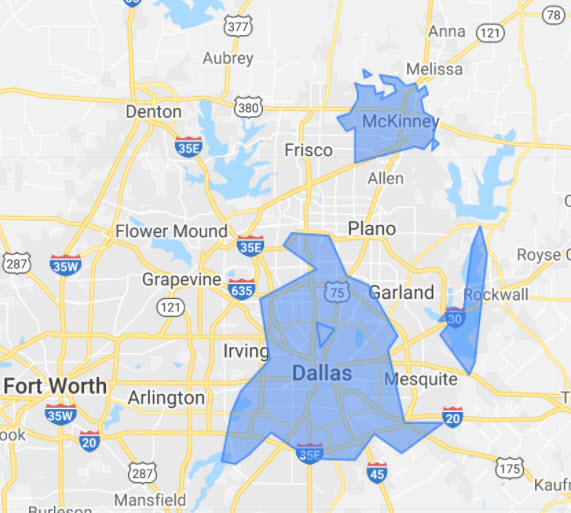
With Google Keyword Planner, we can select any number of cities and suburbs in a cluster to see how many people are typing a specific query and its variations. In this example, I’ve selected HVAC services in McKinney, TX, and Dallas, TX.

Now, we can see exactly how many people are searching for this term and similar queries in those specific locations.
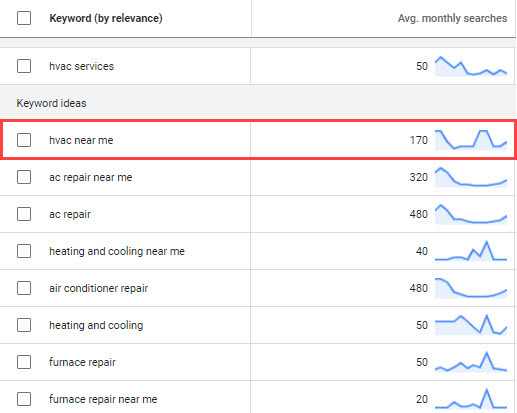
In this example, it looks like users in Dallas and McKinney are typing “hvac near me” more often than “hvac services” on its own, so it would be important to emphasize the location near the keyword. “Dallas hvac services” will have more impact than using “hvac services” on its own.
However, none of the queries in the screenshot above represent users who include the location in the query itself. All of these queries are from people who (correctly) assume that Google will automatically localize their search results.
Location/Local Query
Sometimes, when users need a service, they specify their location or where they want to receive that service. A person in search of a dentist near their kid’s school might type “Plano kids dentist,” even though they live in Frisco.
Keyword research should reveal how users most commonly phrase a query.
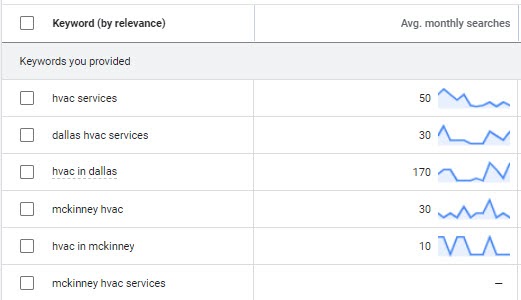
These results tell us specifically how many people in the areas of Dallas and McKinney include “Dallas” or “McKinney” in a search query. The list includes variations of how people search for the service as well, whether it’s city keyword or keyword in city. We’ve confirmed that regionally, people like to include the city (HVAC in Dallas, 170 SV) or “near me” (HVAC near me, 170 SV) when they look for HVAC services.
National/General Query
Google’s Keyword Planner can also be used to compare user intent at the local level with user intent at the national level. By understanding how people search for HVAC services across the United States, we gain information about whether user behavior in the Dallas area is unique or statistically similar to the general population.
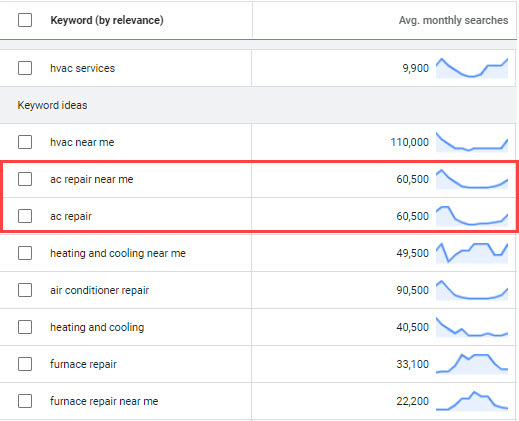
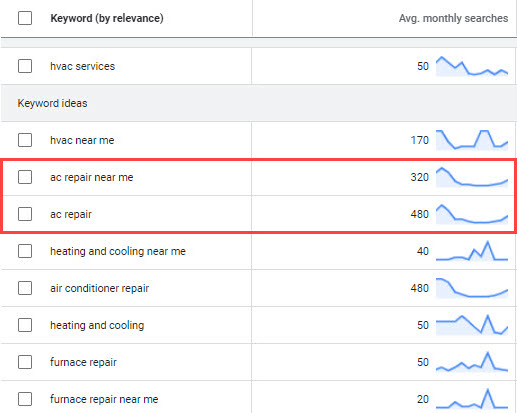
By comparing local and national data, we can see that nationally the same number of people type “ac repair” and “ac repair near me.” Meanwhile, in Dallas/McKinney, slightly more users search for “ac repair” and don’t include “near me.” Insights like these contribute to the decision-making process for keyword prioritization, content strategy, and location targeting.
National/Local Query
Lastly, selecting a country (in our case, the U.S.) on Google’s Keyword Planner can be used to determine how many people are typing “Dallas HVAC services” outside of the greater Dallas area. These users might be moving to Dallas, are searching from out of town, or are random marketers writing a blog post about local SEO.
Here are search volumes for people who include “Dallas” in their HVAC queries across the U.S.:
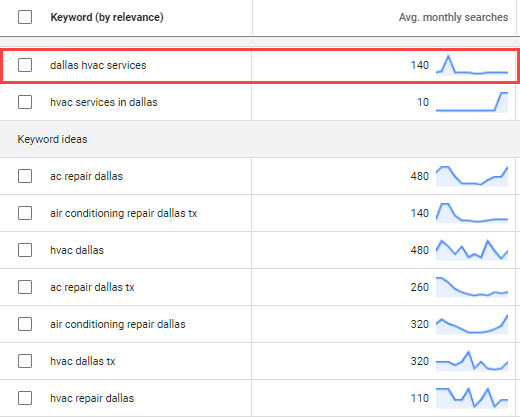
Let’s compare this national data to the local data for these types of searches in Dallas/McKinney.
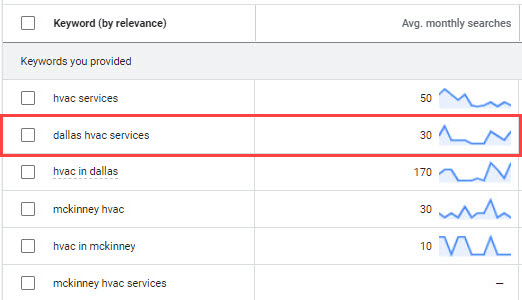
At the national level, “Dallas hvac services” receives 140 searches per month. At the local level, “Dallas hvac services” receives 30 searches per month. This means that around 78% of searches for “Dallas hvac services” happen outside of the greater Dallas area.
So, how do these four types of data from the Keyword Planner come together? We now know that:
- For HVAC terms, users like to include the location or “near me.”
- Users in the Dallas area type “ac repair” on its own more often than including their location.
- People outside of the greater Dallas area actively search for “ac repair Dallas,” and similar terms.
To finalize our strategy with this local keyword research for an HVAC company in Texas, let’s gather additional context from some popular SEO tools.
Other Tools
There are dozens of proprietary keyword research tools out there, from tools that generate volume data directly in the search results (Keywords Everywhere) to tools that pull data directly from Amazon (Soovle). For the sake of brevity (thank you for your endurance through this journey), I’ll only cover some of the most popular tools in the industry:
- Ahrefs
- Semrush
- KWFinder
We’ll consider how each tool is useful to local keyword research and how it can round out the details of a stellar local SEO strategy.
Ahrefs Keywords Explorer
Ahrefs Keyword Explorer is known for:
- Estimating how many backlinks it takes to rank for a keyword
- Providing a timeline for the ranking history of a keyword
Typically, these features are examined from the perspective of a national or international campaign. In a high-stakes national ranking environment, large organizations will execute a detailed SEO campaign with a robust off-page and on-page strategy. In local SEO, budgets might not allow for that level of investment, which means we need to be strategic about using this tool and not getting lost in all its details.
What does Ahrefs tell me about local rankings that population data and Google tools can’t?
First, it presents a different story than Google’s Keyword Planner. Not worse or better. Just different.
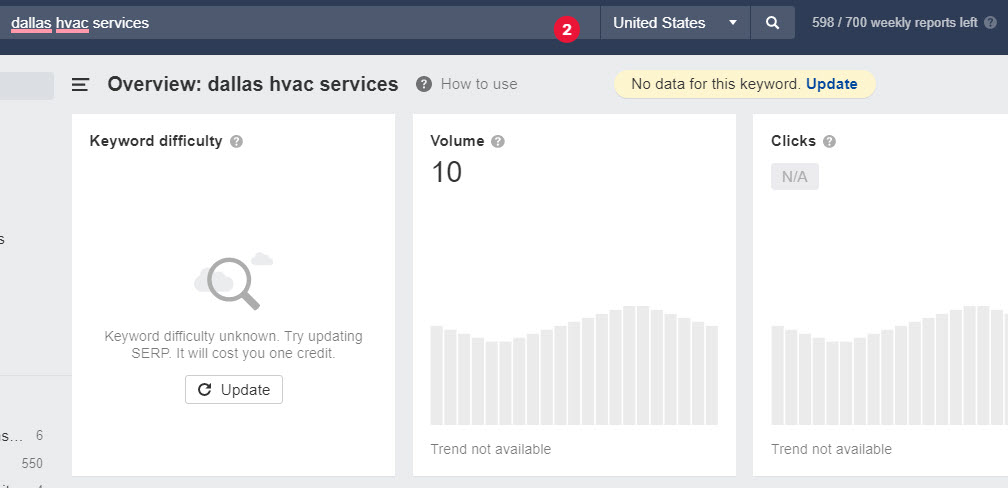
Ahrefs doesn’t have the same level of data as Google’s Keyword Planner; it’s not showing volumes for our target term, “dallas HVAC services.” Despite this initial lack of detail, some useful keyword ideation can be found within the tool’s “Search Suggestions” feature.
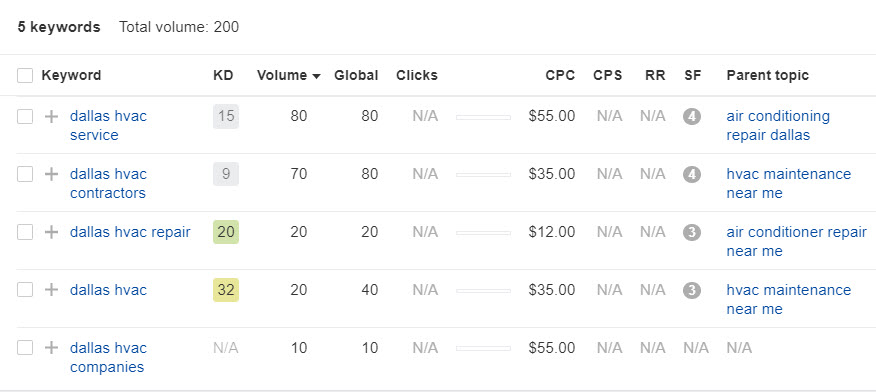
From this feature, we can see that the tool is recommending the singular version of the keyword we entered—“dallas hvac service”—rather than “dallas hvac services.” We gain some insight from this minor difference; what’s the difference in a user’s thought process when they type “service” rather than “services”? The suggestions also point to something that should have been obvious in Google Keyword Planner but was not:
HVAC is a B2B term
The Ahrefs “Search Suggestions” feature is smart and immediately signals to us that the keyword “hvac” isn’t used by homeowners. Any phrases related to “air conditioning” have been relegated to the “Parent Topic” category on the right. We receive a clear picture of the user intent for this phrase by seeing “dallas hvac contractors” and “dallas hvac companies” as B2B terms.
Semrush
Marketers developing a national SEO strategy typically rely on the Semrush Keyword Magic Tool, but other Semrush features include resources that are uniquely beneficial to local SEO.
Semrush’s “Organic Research” filter provides data for the Local Pack.
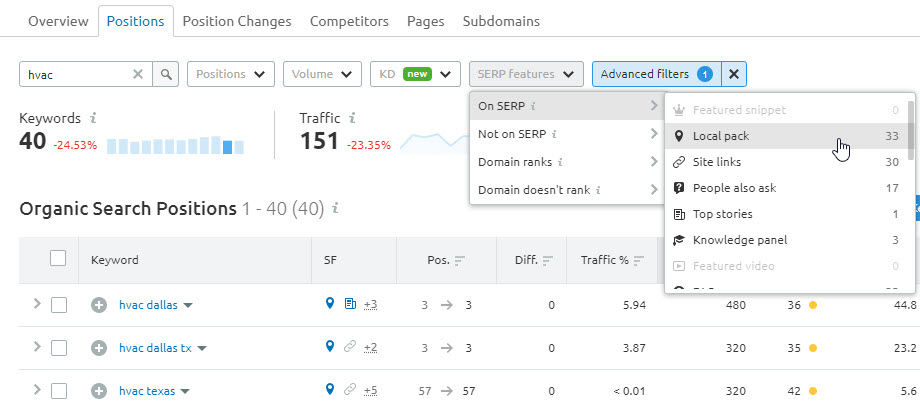
When we select this filter, we only see terms for our website that appear in the Local Pack.
Terms in the Local Pack:
- Hvac dallas
- Dallas hvac tx
- Hvac companies in dallas
- Dallas hvac service
Terms not in the Local Pack:
- Hvac jobs in dallas
- Diy hvac maintenance
- Hvac technician jobs dallas tx
The difference in user intent between these terms is clear (wanting a job vs. wanting to hire a company). Using this data, the SEO practitioner can refine keyword strategy specifically for rankings in the Local Pack.
KWFinder
Besides the Keyword Planner, this is one of the few tools out there that includes your location in a search. Developed by Mangools, KWFinder closely resembles the features of other keyword research tools but is filtered to a local community.
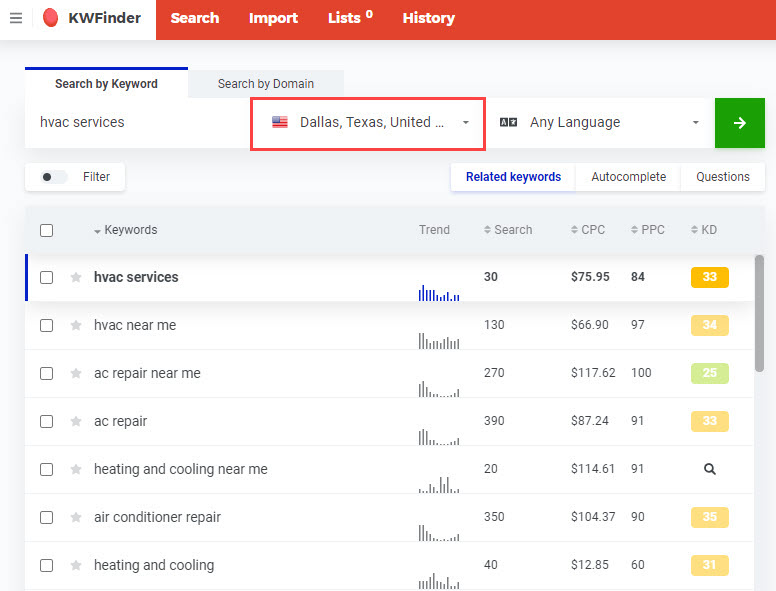
I’ve placed the data in a sheet to compare it to the data in Google’s Keyword Planner.

These are close similarities in volume! Google is one of the primary data sources for KWFinder, but the tool has slightly lower volumes because it doesn’t group close variants for a term. Google’s Keyword Planner often takes terms like “hvac service” and “hvac services” and lumps them into one search volume, making it difficult to get a clear picture of search patterns.
Ultimately, KWFinder is a good option for businesses in need of an affordable tool that combines the location data of the Keyword Planner with the analysis of traditional tools like Ahrefs or Semruush.
Wrapping Up
Local keyword research isn’t a “plug and play” exercise. It’s a cave of trials, and as we’ve gone through this exercise for a Texas HVAC service provider, we’ve begun to understand that:
- Through Google Analytics and Search Console, we know the website ranks equally across three major cities in Texas, but we should probably choose one of these as a starting point.
- Through population research, we know the website could more easily achieve rankings in low-competition Texas suburbs (e.g., Plano) with high populations.
- Through Google’s Keyword Planner, we know the website will see the most success if we emphasize the location to align with user behavior in and outside of Dallas.
- Through other tools like Ahrefs and Semrush, we know that HVAC is a B2B term, and most rankings for it are in the Local Pack.
While data-driven keyword research might look like a bunch of words and numbers, those aren’t really the point. Local SEO is a journey through the local search microcosm, and the data is just another piece of that framework. Use the local search microcosm to ask the right questions and use keyword data from these tools to answer those questions.
Traffic, population, and keyword volume data can answer questions for a campaign, but it can’t reflect the final decisions made by users and search engines. To conclude our adventure through local SEO and keyword research, we’ll pull it all together. The local search microcosm, user intent, and keyword data all contribute to a robust strategy, but they don’t consider how this data will actually apply to the website itself.
Part four of this series will cover some final pieces of context, from what competitors are doing to how your website presents its content.
The post How to Do Local SEO, Part Three: Local Keyword Data appeared first on Portent.

